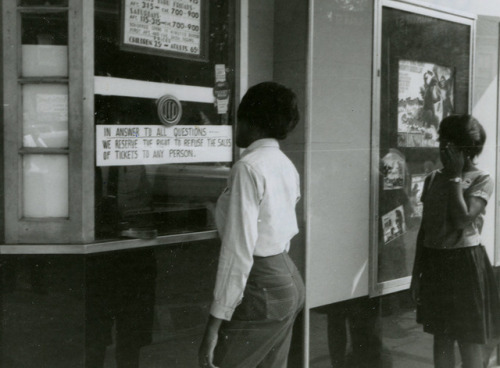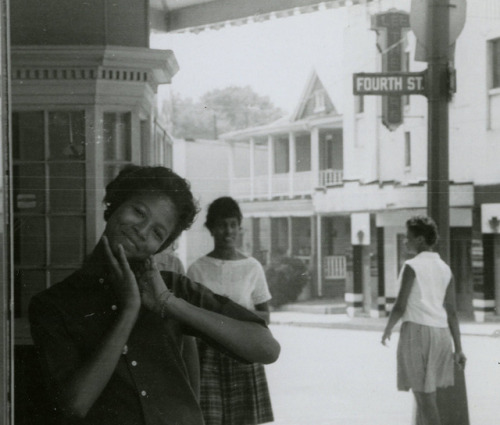#brown v board of education
Protesting segregation at the State Theater in Farmville, Virginia, 1963
A police photographer records the actions of student protesters attempting to purchase tickets to King Kong vs. Godzilla at the whites-only State Theater. Some students hid their faces to thwart the evidence gathering, while others, like Darwyn White, smiled a challenge.
State Theater Protest photographs from the VCU Libraries’ Freedom Now Project.
On May 17, 1954 the Supreme Court handed down its unanimous decision in Brown v. Board of Education: “in the field of public education the doctrine of ‘separate but equal’ has no place.” Change would come too slowly, but the decision was a landmark for the nation.
VCU Libraries Freedom Now Project gives you the opportunity to explore photographs from one Virginia county’s response to Brown v. Board of Education.
Post link
On This Day In History
May 17th, 1954: Brown v. Board of Education of Topeka, Kansas. A unanimous decision by the Supreme Court of the United States outlaws racial segregation in public schools.
Pictured here is an annotated map of busing routes for George W. Watkins School, which was used as an exhibit in the U.S. District Court for the Eastern District of Virginia, Richmond Division Case Green v. New Kent County. The decision of the United States Supreme Court to desegregate schools in the 1954 landmark case Brown v. Board of Education was just the beginning of the desegregation fight. In order to meet the provisions outlined by the Supreme Court in Brown v. Board of Education, while also avoiding integrating white and black school populations, many schools implemented “freedom of choice” plans. These plans did not explicitly prevent black students from attending a white school, or vice versa, but it put the responsibility of integration on the student and their family. “freedom of choice” plans placed institutional hurdles and reinforced social stigma against integrating black and white schools, which effectively halted desegregation efforts in the South.
In 1965, parents in New Kent County, Virginia, complained that the school district was deliberately maintaining a segregated school system after Brown v. Board of Education. They brought their case to the U.S. District Court for the Eastern District of Virginia, Richmond Division where the court upheld New Kent Court’s “freedom of choice” plan. The case was then brought to the U.S. Court of Appeals for the Fourth Circuit, which affirmed the lower court’s decision (though it returned the case to the lower court for a more specific plan to desegregate teachers).
The case made it to the Supreme Court in 1968, which reversed the lower court rulings. The Supreme Court stated that the New Kent district was deliberately maintaining a segregated system and that “freedom of choice” was not sufficient to bring about desegregation. Justice William J. Brennan, Jr., writing for a unanimous court, declared: “It is incumbent upon the school board to establish that its proposed plan promises meaningful and immediate progress toward disestablishing state-imposed segregation.”
Educators and parents can review documents and create activities for students by visiting DocsTeach, which features digitized records from all three cases, as well as contextual information to help students learn more about this topic: https://www.docsteach.org/documents?filter_searchterm=Green+County+School+Board+New+Kent+County&searchType=all&filterEras=&filterDocTypes=&sortby=date&filter_order=&filter_order_Dir=&rt=cthCC3zZbaWv&reset=1
You can also learn more by visiting our online catalog (catalog.archives.gov) and reviewing digitized documents from each case.
Post link
A recent episode of Malcolm Gladwell’s podcast, Revisionist History, delves into the unfair dismissals of black teachers after the Supreme Court’s ruling in Brown v. Board of Education. Gladwell pieces together a narrative drawn extensively from archival sources, including oral histories from Duke University Library’s collection: “Behind the Veil: Documenting African-American Life in the Jim Crow South.”
Gladwell explains that as school systems consolidated, white educators kept their teaching or administrative positions and black educators were fired in many cases or pushed out through marginalization. The National Education Association (NEA), as an advocate for the fair hiring practices of educators, drew attention to this inequity through the dissemination of reports, lawsuits, and statistics for decades after the ruling. The archives of the NEA are held by GW Libraries Special Collections and contain details of this injustice.
After our NEA Archivist, Vakil Smallen, heard the episode he immediately went to the collections to look for further original documentation of what Gladwell described. He found many sources and over the next few weeks we will share examples on our Tumblr.
TheNEA Task Force on School Desegregation in Louisiana wrote a report in 1970,16 years after the Court’s ruling, that details the many and varied accounts of black teachers being humiliated into quitting if they were not outright fired.
What follows are some of the examples of the mistreatment endured by educators of color in the Louisiana public school system documented in this 1970 report:
- Former administrators being demoted to teaching or janitorial positions in newly integrated schools.
- In one case, an elementary school principal with 27 years of experience was asked to teach a subject he was not certified in and he was later terminated on the grounds that he was unqualified to properly instruct on this subject.
- Some accounts detail former principals being reduced to offices in closets or given menial tasks such as being put in charge of attendance or distributing textbooks instead of leading schools.
- Black teachers were far less likely to receive the school assignment of their choice and had to accept assignment to an unwanted school or quit.
- Black teachers were instructed that they could not discipline white students for misbehavior.
Images above:
1. Photograph taken from the December, 1967 issue of the Southern Education Report.
2. Report Snapshot: Sample text from the NEA’s report on Desegregation in Louisiana
3. Headline taken from the Oct. 6, 1968 issue of The Advocate, a Baton Rouge based paper serving the entire state.
Post link







